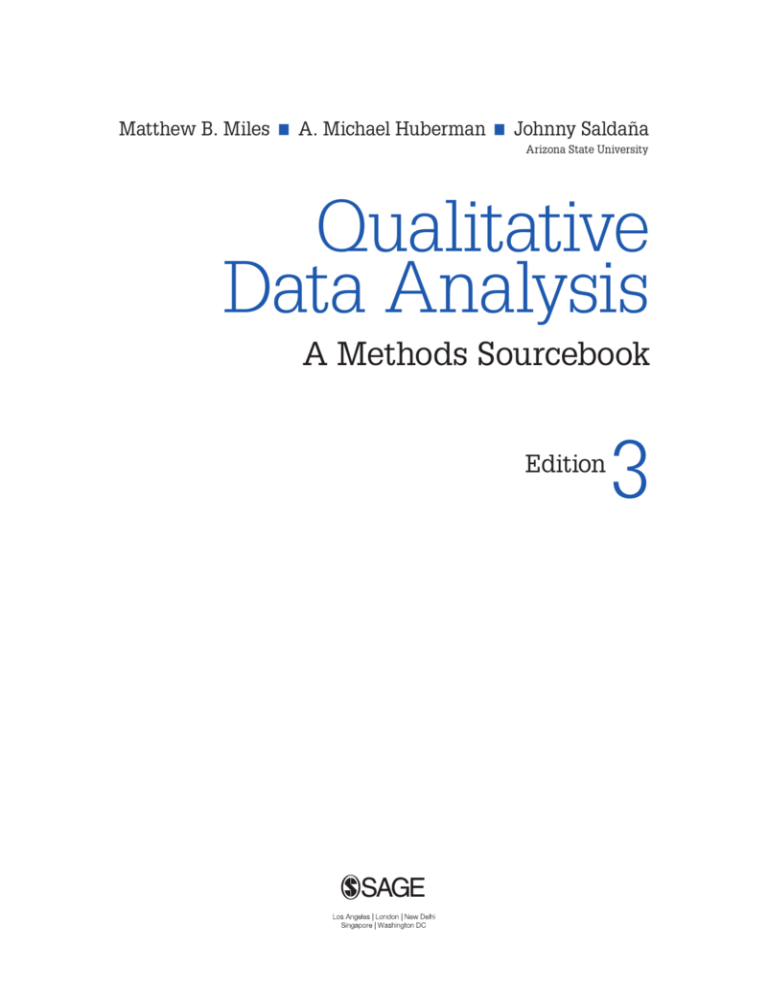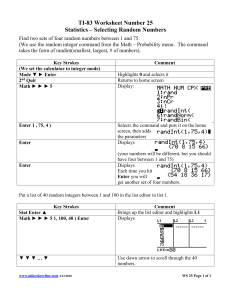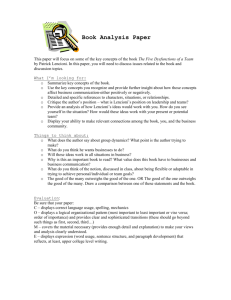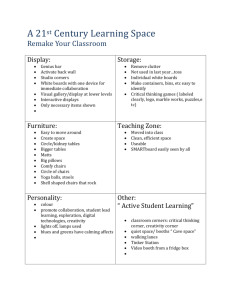Designing Matrix and Network Displays
advertisement

Matthew B. Miles • A. Michael Huberman • Johnny Saldaña Arizona State University Qualitative Data Analysis A Methods Sourcebook Edition 3 Brief Table of Contents List of Displays xiii Preface to the Third Edition by Johnny Saldaña xvii Acknowledgments From the Second Edition by Matthew B. Miles and A. Michael Huberman About the Authors xxi xxiii Part One – The Substantive Start . . . . . . . . . . . 1 Chapter 1 - Introduction 3 Chapter 2 - Research Design and Management 17 Chapter 3 - Ethical Issues in Analysis 55 Chapter 4 - Fundamentals of Qualitative Data Analysis 69 Part Two – Displaying the Data. . . . . . . . . . . 105 Chapter 5 - Designing Matrix and Network Displays 107 Chapter 6 - Methods of Exploring 121 Chapter 7 - Methods of Describing 161 Chapter 8 - Methods of Ordering 193 Chapter 9 - Methods of Explaining 221 Chapter 10 - Methods of Predicting 255 Part Three – Making Good Sense. . . . . . . . . 273 Chapter 11 - Drawing and Verifying Conclusions 275 Chapter 12 - Writing About Qualitative Research 323 Chapter 13 - Closure 339 Appendix – An Annotated Bibliography of Qualitative Research Resources 345 References363 Author Index 369 Subject Index 373 5 Designing Matrix and Network Displays Chapter Summary This chapter provides fundamental principles for the design and content of two analytic display methods: (1) matrices and (2) networks. These methods condense the major data and findings from a study to further analyze and/or to represent and present the conclusions. Contents Introduction Display Format Options Matrices Networks Timing of Display Design Formatting the Matrix Template Entering Matrix and Network Data Making Inferences and Drawing Conclusions From Matrices and Networks The Methods Profiles Closure and Transition Chapter 5 | Designing Matrix and Network Displays 107 Introduction Lengthy, unreduced text in the form of interview transcripts, field notes, documents, and so on is cumbersome because it is dispersed over many pages and is not easy to see as a whole. It is sequential rather than simultaneous, making it difficult to look at two or three variables at once. Comparing several extended texts carefully is very difficult. It is usually poorly ordered, can get very bulky, and can make us feel monotonously overloaded. The same objections apply with even stronger force for readers of our final reports. They need, if not deserve, a concise delivery of what we analyzed. And in this highly visual culture, showing rather than telling can make a more effective and memorable impact on our audiences. A major purpose of this text is to encourage the creation and dissemination of matrix and network displays for qualitative data. The central argument of this book is “You know what you display.” Credible and trustworthy analysis requires, and is driven by, displays that are focused enough to permit a viewing of a full data set in the same location and are arranged systematically to answer the research questions at hand. A “full data set” does not, of course, mean the complete corpus of interview transcripts, field notes, documents, and so on. Rather, the condensed, distilled data presented are drawn from the full range of persons, events, and processes under study. With extended text, there can easily be “selective stacking” of the data. An organized display wards off this problem. The idea of display is central to this book. By “display” we mean a visual format that presents information systematically so the user can draw conclusions and take needed action. Although such displays may sometimes be busy, they will never be monotonous. Most important, the chances of drawing and verifying conclusions are much greater than for extended text, because the display is arranged coherently to permit careful comparisons, detection of differences, noting of patterns and themes, seeing trends, and so on. Quantitative researchers have software packages that can develop publishable tables, graphs, and charts. Qualitative researchers have CAQDAS programs for our unique approaches to data analysis. And even basic Microsoft Office programs such as Word and Excel are sufficient for most matrix and network displays. But the qualitative analyst has to handcraft appropriate data display formats because each project is unique. As yet, there are few familiar, agreed-on data setups among qualitative researchers, so each analyst has to adapt those of others or invent new ones. The display ideas we offer in this book are nothing more than that—ideas, not prescriptions, for qualitative data display. Not everyone loves matrices and network displays—and not everyone thinks visually. But displaying your condensed data in a systematic way has immense consequences for your understanding. It requires you to think about your research questions and what portions of your data are needed to answer them; it requires you to make full analyses, ignoring no relevant information; and it focuses and organizes your information coherently. These advantages are repeated when you include displays in a final report; the reader can re-create your intellectual journey with some confidence. 108 Part II: Displaying the Data Display Format Options Deciding on and generating the format for displaying qualitative data are important first steps. Your template is a visual outline, of sorts, for the data to be filled in. Formats can be as varied as the imagination of the analyst, but the ones described in this book tend to fall into two major families: 1. Matrices, with defined rows and columns 2. Networks, a series of nodes with links (lines and arrows) between them Data entries, however, are multiform: short blocks of text, quotes, phrases, variable labels, ratings, abbreviations, codes, categories, symbolic figures, labeled lines (dashed or solid), arrows (one way or two way), and so on. The display format and content of the entries will depend on what you are trying to understand: a general situation, detailed chronologies, the actions of people in different roles, the interplay of variables, and so on. In other words, form follows function: Formats must always be driven by the research questions involved and your developing concepts. Formatting determines which variables will be analyzed in which ways. If a variable isn’t included in the format, it won’t get compared with another variable. And it depends on how far along you are in the study and what has priority right now. The need might be for eyeballing data in an exploratory way. Or it could be for carrying out detailed analyses; for setting up data to use in another, more differentiated display; for combining parallel data for a single case; for combining data from several cases; or for reporting findings. A good format will allow all of these uses to some degree but inevitably will do some well and others less well. Let’s examine the two major families of displays with examples and illustrations. Matrices A matrix is essentially the “intersection” of two lists, set up as rows and columns. Let’s take a look at a sample format, explaining and labeling it as we go. Display 5.1, a table drawn with Microsoft Word software, is aimed at understanding the effects of assistance supplied to a school site—the Masepa Case—by various sources. This was part of a school improvement study that observed how a new project innovation was implemented. The matrix format calls for the researcher to address five related variables, to distinguish two of them according to time, to pool responses, to align some responses along an evaluative scale, and to explain the response pattern for each type of assistance source. Here, condensed information from 30 pages of field notes has been packed into a single page. Note that the data are abstractions: There are no quotes, and generalizations and other inferential remarks appear in the last two columns. The Longer-Run Consequences and Researcher Explanations are not direct condensations of participants’ remarks or of researchers’ observations. Rather, for any given consequence, such as the one in the top row (“Users are helped administratively and substantively, feel obliged to do ECRI [Exemplary Center for Reading Instruction] with minor adaptations”), the researcher Chapter 5 | Designing Matrix and Network Displays 109 110 Part II: Displaying the Data 1. provides materials 2. demonstrates, models 3. answers requests 4. encourages 5. circulates, controls 1. comparing practices with others 2. debugging, complaining 3. learning about new parts 4. encouragement 1. sharing materials 2. exchanging tips, solutions 3. comparing, encouraging 1. tips for presentations 2. solution to short-term problems 3. encourages 4. serves as successful model ++ + ++ ++ ± ++ + + + + + ++ ++ Helping Teacher + + 1. facilitates practice 2. helps expand beyond core format 3. maintains effort 4. stimulates 1. increases stock 2. new ideas, practices; problems solved 3. motivates, stimulates 2. cathartic, solves short-run problems 3. expands repertoire 4. gets through rough moments 1. encourages, regulates 1. reduces effort, increases repertoire 2. trains, facilitates use 3. problems solved rapidly 4. maintains level of effort 5. ambivalent: helped yet coerced 1. pressures non-users 2. building administrators have material, administrative support 1. relieves pressure, encourages 2. helps early implementation 3. feeling policed 4. feeling backed-up, substantially helped Short-Run Effects (User’s ‘State’) reliable, unthreatening backup provided in school increases commitment, regulates use (decreases deviance) creates reference group, gives users a voice, solves ongoing problems and lowers anxiety new, experienced users receive systematic instruction, follow-up, materials; stay with program and are careful about making changes in it program is perceived as supported, assisted, ‘protected’ by central office users are helped administratively and substantively, feel obliged to do ECRI with minor adaptations Longer-Run Consequences Source: Miles, M. B., & Huberman, A. M. (1994). Qualitative data analysis: An expanded sourcebook (2nd ed.). Thousand Oaks, CA: Sage Publications. Legend ++ = very effective + = effective ± = mixed effective – = ineffective Trainers in Target School, Other School Teacher-Users in Other Schools: Target Schools + 1. promotes ECRI 2. answers building administration, trainers’ requests + ++ Central Office Administration User-Helping Teacher Meetings 1. authorizes changes 2. eases schedules 3. controls fidelity 4. consults, offers solutions Types Provided ++ ++ + User’s Assessment Building Administration Location Effects Matrix: Assistance Location and Types (Masepa Case) Display 5.1 elaborate and effective lateral network: trainers seen as peers additional source of assistance, which increases as number of users grows multi-purpose forum which consolidates use and users, defuses opposition personalized in-service mechanism, with both training and assistance allows for mastery and spread of ECRI in ‘faithful’ format central office able to push program and answer requests, yet not perceived as main actor by users administration, authority, servicing, availability and flexibility lead to sustained, faithful implementation model Researcher Explanations has looked at the data segments in the three preceding columns, checked to see whether they covary in some patterned way, and drawn a second-order generalization. In this case (see the first row, first column—Building Administration), themes such as “Eases schedules,” “Consults, offers solutions,” “Relieves pressure, encourages,” “Helps early implementation,” and the Users’ Assessment of generally positive magnitude codes all suggested the reception of help and a sense of user obligation for reasonably faithful implementation. A similar process of inductive inference occurs under Researcher Explanations. Overall, the matrix is a tabular format that collects and arranges data for easy viewing in one place, permits detailed analysis, and sets the stage for later cross-case analysis with other comparable cases or sites. As the chapters progress, you’ll learn how matrices can order data by case or time and can arrange and stack their cells in such a way as to create meta-matrices, which contain multiple rows within a single row and multiple columns within a single column. Networks A network is a collection of nodes or points connected by links or lines that display streams of participant actions, events, and processes. Networks lend themselves well to a case-oriented approach that re-creates the “plot” of events over time, as well as showing complex interrelationships between variables. They give us the kinds of narratives that tend to get chopped up analytically in matrices. They are very helpful when you want to focus on multiple variables at the same time for readily analyzable information at a glance. Display 5.2 is a network model from McCammon et al.’s (2012) study of how high school speech classes influenced and affected adolescents and their adulthood after graduation. The network is an outline of “plot points” for an accompanying research narrative. Display 5.2 A Network Model of “Lifelong Impact” From High School Speech Participation Adolescents Friendships Acceptance and Status Competitions Winning Speech Classes Good Coaching Sense of Belonging Positive Affects Adolescent and Adult Confidence Source: Saldaña, J. (2013). The coding manual for qualitative researchers (2nd ed.). Thousand Oaks, CA: Sage Publications. Chapter 5 | Designing Matrix and Network Displays 111 The proverb of this research story—the theory—suggested by the oval nodes is as follows: When Adolescents enroll in high school Speech Classes, they gain Confidence as an Adolescent and Adult. But that story line is too thin and needs to be fleshed out through an analytic narrative. The rectangular nodes attached to Speech Classes indicate that the classroom content must be led by a teacher who provides Good Coaching. Students must also feel that they are part of a classroom community through a Sense of Belonging. Not all but some students from those classes participated in extracurricular speech tournaments or forensic Competitions (debate, extemporaneous speaking, oral interpretation of literature, etc.). Thus, a separate trajectory or stream is drawn. Respondents testified that participation in these events developed Friendships, a sense of Acceptance and Status, and thus Positive Affects, especially for those who reached the achievement of Winning at these competitive events. Regardless of whether one won or not, the respondents’ stated outcome was Confidence—both as an Adolescent and later as an Adult. The bidirectional arrow between Speech Classes and Adolescent and Adult Confidence suggests a cyclical or interactive effect: The more speech classes you took, the more confident you became; the more confident you became, the more likely you continued participating in speech classes and competitions. Networks are also effective heuristics for higher level analyses such as discerning causation, analyzing longitudinal trends, and developing hypotheses and theories. They are not any easier or harder to construct than matrices—both display forms take comparable amounts of time and thought to design and assemble. Selected CAQDAS programs, however, can greatly assist with complex network construction. Display 5.3 illustrates QDA Miner 4’s ability to “calculate” and assemble a three-dimensional network of codes as weighted nodes, with links suggesting interrelationship. These graphics are extremely helpful as diagnostics of data analysis in progress and as displays themselves for final reports. See Knowlton and Phillips (2013) for a diverse collection of logic model graphic designs and the online Periodic Table of Visualization Methods for additional ideas (http://www.visual-literacy.org/periodic_table/periodic_table.html). Timing of Display Design When should display formats be generated? Analytic displays can be developed either during or after data collection. They can provide preliminary findings about what is happening in the case and suggest leads toward new data. Later, as fuller, more complete descriptions are at hand, these displays can supply the basic material for higher level explanations—that is, plausible reasons for why things are happening as they are. If the format is at hand during data collection, it helps save energy by encouraging focus: You know what information you will be needing. But there are some cautions here. First, qualitative data evolve; later accounts round out, qualify, put in perspective, and disqualify the earlier ones. Analysts scout around, sleuth, and take second and third looks. So there are risks in entering the data into a set format too soon. 112 Part II: Displaying the Data Display 5.3 A QDA Miner 4 3-D Map of a Codes Network Source: Courtesy of Provalis Research, www.provalisresearch.com. Furthermore, for any given research question or issue, you can develop many different displays (literally dozens) using the same set of variables. Each display makes somewhat different assumptions; each has trade-offs among advantages and costs. Another caution is that display formats nearly always evolve, too. The later ones are more data sensitive than the earlier ones, as things become clearer. So our general advice is to generate rough formats early during data collection and revise them to a firmer state closer to the end of data collection, when they can be grounded more contextually and empirically. Expect to make several passes or iterations before the first format of the display is working right. Test a proposed format by entering data. Unworkable or confusing formats, or those that do not incorporate all of the relevant data, will show themselves rapidly. Formatting the Matrix Template There are no fixed canons for constructing a matrix. Rather, matrix construction is a creative yet systematic task that furthers your understanding of the substance and meaning of your database, even before you begin entering information. Thus, the issue is not whether you are building a “correct” matrix but whether it is a helpful one that Chapter 5 | Designing Matrix and Network Displays 113 will give you reasonable answers to the questions you are asking or suggest promising new ways to lay out the data to get answers. At a deeper level, the message of this book is not “Use these matrices” but “Think display. Adapt and invent formats that will serve you best.” Given these choices, what can we say informally about the best and easiest ways to build the templates/outlines/frameworks of matrix displays? We state these briskly, as friendly advice rather than as harsh prescription: • Look at your research question(s) and key variables, and think of the data that are or will be available. Sketch the matrix outline roughly using paper and pencil. • Get a colleague to look at your initial format, to help you detect the assumptions you are making and to suggest alternative ways to display your data. • Set up the matrix template by using a text program, database management, or CAQDAS software. Try to make the display completely readable on your monitor screen or on one printed sheet of paper, if possible. You have to be able to see it all at once. • Don’t try to include more than a dozen or so variables in rows or columns; five or six is more manageable. If you are drawn to a design with larger numbers of variables, plan to cluster or partition them as meta-matrices. In effect, regroup the matrix into “streams” or adjacent “families.” • The simplest matrices are organized in two dimensions. You have a choice to move to more complexity if the data demand it by creating partitions for metamatrices—rows within a row and/or columns within a column (to be illustrated in forthcoming chapters). • If the matrix is an ordered one, expect to transpose rows and columns for a while until you have a satisfactory version. Most text-based software, database management, and CAQDAS programs can do this quite easily. • Always stay open to the idea of adding new rows or columns, even late in your analysis operations. • Keep rows and columns fine grained enough to accommodate meaningful differentiations in the data but not so fine as to bury you under indiscriminate detail. • Keep in mind that any particular research question may require a series of displays; for example, an initial partially ordered descriptive matrix may lead to a small summary table and then to a network display. Think ahead to this possibility, but allow new matrix forms to emerge as the analysis proceeds. Creating matrix templates is usually a matter of a few minutes; revising them as the early items of data are entered is also quick work. Virtually all CAQDAS programs can enable reformatting as data are entered and coded. The time taken to enter data into a display actually depends on the following: (a) the number of variables or dimensions in the display, (b) the number of respondents and cases, and (c) the kind and number of transformations made. 114 Part II: Displaying the Data Which types of row and column headings or network bin labels are possible? The set is almost infinite, ranging from cases to variables. To illustrate, here is just a sample of types adapted from Gobo (2008), Lofland, Snow, Anderson, and Lofland (2006), and Bogdan and Biklen (2007). For concreteness, we use examples from health care settings: Individuals: Jane Hughes, RN, Dr. Luis Garcia Roles: patients, nurses, doctors, administrators Relationships and groups: patient–spouse, nurse–resident, intensive care unit staff, accounting department, surgical team Settings within sites: operating room, emergency room, cafeteria Sites as wholes: Good Samaritan Hospital, downtown health maintenance organization Specific actions (what people do and say): diagnostic questions, answers, listening, information giving, comforting Events (marked-off happenings or occurrences): admission, operation, discharge Activities (regularly occurring, connected sets of actions): grand rounds, lab tests, billing Strategies (activities aimed toward some goal): rehabilitation plan, nutrition counseling, radiation treatment Meanings and perspectives (how people construe events): patient and physician views of an HIVpositive diagnosis, the experience of labor and childbirth Attitudes, values, and beliefs: resentment toward physician seniority, pro-choice versus pro-life, patient anxiety Emotions and states: staff morale, patient fear, critical condition Processes (ongoing flows, phases, stages, cycles, changes over time): wound healing, convalescence, triage, decision making, social support, bereavement Entering Matrix and Network Data Generally, the choice of data for display entry must be driven by the particular row and column headings involved or by your definitions of network nodes and links. But these seemingly straightforward tasks are critical issues in qualitative data analysis. The conclusions drawn from a display can never be better than the quality of the data entered. A completed matrix or network may look coherent, plausible, and fascinating, but if the data were poorly collected in the first place or were entered in a hasty, ill-partitioned, or vague way, the conclusions are suspect. We offer some guidelines below for data entry into display formats: Chapter 5 | Designing Matrix and Network Displays 115 • Even a dense matrix displays only a very small percentage of the available data. There is always a great deal of selection and condensation from the mass of field notes. Be aware of how you make that selection and how you boil the data down. You are not throwing away your field notes—you can always refer back to the full material. • More information is better than less: Too thin cell entries keep you away from the meaning of the data. • Be clear about the forms and types of data you want to enter: direct quotes, paraphrases, general summary judgments, ratings, and so on. • Use codes and software search functions to locate key material. Entering these data is much easier with text-based software, database management, or a CAQDAS program having multiple screens; they permit you to retrieve coded chunks to one screen or region and to select/edit/condense them on another. • Keep an explicit record of the “decision rules” you followed in selecting data chunks for entry (e.g., the extent of agreement among respondents or data types, the intensity of respondents’ feelings, the basis for making judgments or ratings). Otherwise, you may delude yourself retrospectively, forget how you did it, or shift your decision rules during the process. • When data are missing, ambiguous, or were not asked for from certain respondents, show this explicitly in the display. • Don’t lock up your format until later in the process. Entering data tests the adequacy, realism, and helpfulness of the display format. Keep revising it as needed. • Be open to using numbers, direct quantities, or judgments in the form of ratings, scales, or magnitude codes, when applicable to the study. • Get a colleague to review your display, along with your decision rules and written-up field notes, to check the procedural adequacy of your work. Such audits are time-consuming, but used selectively, they are an important check on the “confirmability” of the procedures you used. You always have choices about the level and type of data to be entered. For example, you can include the following: 116 Direct quotes, extracts from written-up field notes: “Surgeons are basically macho types—the best ones, I mean. They have to be, but they can’t help it.” Summaries, paraphrases, or abstracts: Patient advocate seems increasingly distrusted. Rules for residents’ time use largely ignored. Researcher explanations: Patient uncertainty about diagnosis is a function of lifethreatening conditions and use of denial as a buffer. Ratings or summarized judgments: Risk reduction behavior after cardiovascular bypass: worse, no change, improved, much improved. Combinations of the above: Risk reduction: improved. Diet (“I even tried broccoli”), some exercise (walks 20–30 minutes daily), and smoking (reduced, is considering using a nicotine patch). Part II: Displaying the Data Making Inferences and Drawing Conclusions From Matrices and Networks The test of any display is what it helps you understand—and how trustworthy that understanding is. In the next five chapters, there will be many specific tactics for conclusion drawing and verification through the use of boldface. Each has its specific advantages and pitfalls, which we will discuss in Chapter 11. Here, we offer some preliminary general advice: • It’s always helpful to start with a quick scan—a “squint analysis” or “eyeballing” down columns and across rows and through network pathways to see what jumps out. Then, verify, revise, or disconfirm that impression through a more careful review. • Any given display will always have multiple tactics used on it. The ones we have used most frequently for drawing first conclusions are noting patterns, themes; making contrasts, comparisons; clustering; and counting. • Displays never speak for themselves—either to you or to the reader; accompanying text is always needed. As conclusions form in your mind, always write text explaining them. Make your conclusions explicit. The process of writing inevitably leads to reformulation, added clarity, and ideas for further analysis. Writing is itself a form of analysis. • First conclusions drawn from a display almost always need to be checked against written-up field notes. If a conclusion does not ring true at the “ground level” when you try it out there, it needs revision. Look at the raw data to guard against this. Even better, check with your research colleagues and the participants themselves, when possible. • Any early conclusion typically needs confirmation, checking, and verification. The most frequently used tactics we’ve used are as follows: following up surprises, triangulating, making if-then tests, and checking out rival explanations. • Be sure your descriptive understanding is clear at the individual or within-case level first before you try to understand cross-case patterns. • Remember that analysis usually has to go beyond descriptive summation and reach toward explanation. Clarify the conceptual implications of your conclusions— that is, how they tie into your or someone else’s theory of social behavior. Analyses that yield verifiable but poor-meaning conclusions are of little use to anyone. Conclusions about data displays normally appear in what we call an analytic text or narrative. Analytic narrative draws attention to the features of the displayed data and makes sense of them, knitting them together and permitting the analyst to draw conclusions and add interpretations. It also encourages a return to the field notes to consult information not in the display and to add it to the text for further clarity. Since a display does not speak for itself, analytic text does not stand alone without reference to the display. Chapter 5 | Designing Matrix and Network Displays 117 In fact, the act of writing text as you ruminate over the meaning of a display is itself a focusing and forcing device that propels further analysis. Writing does not come after analysis; it is analysis, happening as the writer thinks through the meaning of data in the display. Writing is thinking, not the report of thought. Stay open on the question of whether the display format you use for analysis should be the same display used for final reporting (the answer is often “yes”). Readers can see for themselves how conclusions were drawn, rather than being handed summarized study results to be taken on faith. Sometimes, of course, a display will be used for intermediate purposes and will not necessarily be shown to readers of the final report. The tradition of presenting basic data is deeply ingrained in reports of quantitative data analysis, so much so that it would be unthinkable for a researcher to present conclusions without data tables or, at least, without reference to working documents containing them. We believe that the same norms should apply to qualitative researchers working within particular traditional genres of inquiry (e.g., ethnography, grounded theory, content analysis, evaluation research, etc.). Some data displays should be a normal part of reporting findings and conclusions. In some instances, of course, a summary table or a boiled-down version may suffice. Where basic matrices or networks are not presented, you owe the reader a clear explanation of the analysis methods used to get to the text. In any case, remember what the reader needs from displays. We can hardly do better than quote Tufte (1986), speaking primarily of quantitative work but with relevance for qualitative researchers: What we are seeking in graphic and tabular displays of information is the clear portrayal of complexity. Not the complication of the simple; rather the task of the designer is to give visual access to the subtle and the difficult—that is, the revelation of the complex. (p. 80) As the saying goes, “Things can be complex without being complicated.” The Methods Profiles In the next five chapters, each method profile will be presented in this format: • Description: The method is briefly described with reference to its accompanying display. • Applications: This section outlines the purposes of the method and its recommended uses for particular research studies or goals. • Example: A study drawn from the coauthors’ previous work is used to illustrate the display, its design, and data entry. • Analysis: The discussion shifts to how the assembled data in the matrix or network were analyzed and interpreted by the researchers. Recommendations for reader applications are also provided. • Notes: Supplemental or concluding comments about the method are offered. The profiles vary in length, depending on the complexity of the method. They are grouped into subcategories within each chapter, when appropriate, if they share a common purpose. 118 Part II: Displaying the Data We also emphasize here that the names we gave to our methods and displays were for convenient description, not for standardization. Who cares whether it is a “caseordered descriptive meta-matrix” or a “predictor-outcome-consequences matrix”? The names may sound like jargon, but don’t worry about that; the issue is how any given display works and how it can further your understanding of the data. All of the methods and displays can be adapted to meet the needs of any particular study. If they seem too complex, simplify; they can be modified easily for studies where the cases are a few individuals. Not every single method has to be used for every single study. Take only what is useful for your research purposes and goals. Focus on the doable while keeping as much richness as you can. Closure and Transition This chapter provides foundations for the next set of chapters—that is, methods of displaying and analyzing qualitative data through five modalities: (1) exploring, (2) describing, (3) ordering, (4) explaining, and (5) predicting. You’re encouraged to read Chapters 6 through 10 in order, for the techniques of one strategy are generally used in the next. Chapter 5 | Designing Matrix and Network Displays 119





